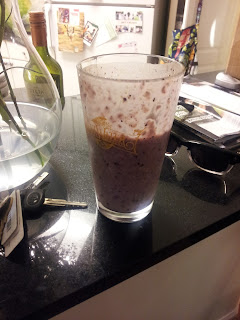Since my real big picture training goal is smashing the Marine Corps Marathon, I didn't modify my training much - there was no taper here, although I did cut yesterday's run by a few miles (four instead of six), with the intention of adding them on throughout the weekend to keep the total mileage the same. My legs have been feeling a bit tired these days when I'm not running, but my performance is getting better and better, so I was optimistic coming into the race...
More than optimistic. My tier one goal was to PR, which made I my target time sub 22:37, which frankly I've been beating on my tempo runs every week. That's the beauty of only running 1-2 5k's each year I guess.
And then the curveball:
Terrifying, right?
Our geriatric beagle has begun to do this great new trick the last few weeks called "reverse sneezing"; basically he starts making a horrible wheezing sound and appears to be on the verge of death, but apparently is perfectly fine and is just having allergies. Last night was one of the nights where his allergy attacks began in the middle of the night and lasted into the ungodly hours, resulting in significant sleep disruption for Christina and me. We didn't get any peace until I picked him up, carried him into the living room and plopped on the couch, at which point he stopped wheezing. Yikes, maybe it's time to vacuum the bedroom...
So race morning comes, I'm a little wonky from sleep disruption, but otherwise feeling good. I stuck to my nutrition plan, which for this short race was simply to skip breakfast and pound a Gu about 20 minutes before the start.
For the first time, I had a few pre-race jitters. I attribute it to Christina not being there - usually that's her job. This was the only race where I've had to wait desperately in the bathroom line, hoping to deliver my payload and get to the line in time. Thankfully the men's line was about 1/5 the length of the women's (anyone surprised?), and I was in and out, smooth sailing. I had jogged over the start area (about a mile from our apartment), done a few quick sprints to get my legs moving fast, and then it was time to go!
The Race
This was a small road race 5k, nothing terribly competitive, run around downtown/midtown Atlanta. It begins and ends in the middle of a nest of our premier tourist attractions - The World of Coke (ooh...), Centennial Olympic Park (you know, because we hosted the Olympic Games that corresponded to the 100th anniversary of the first modern olympics, you know, no big deal), and the Georgia Aquarium (supposedly the largest aquarium in the world).
I've run on all the streets in this course before, so I wasn't expecting any huge surprises. The first mile and a half of this race are relatively flat, transitioning into a very slow, rolling descent with about 60 feet of loss - small potatoes. The second half, on the other hand, features a few very quick 100 foot climbs. Nothing special, but for sure the second half was more challenging than the first. I overheard some other folks chatting at the start line say that this is a fairly easy course, and with the exception of those little uphill dashes, I'd have to agree.
The temperature? Beautiful. According to one of those shopping complex signs, it was just cracking 70 degrees around the time I finished the race.
How did it go?
Smashing! I hit my tier one goal, to PR, as well as my secret goal, which was to crack 20 minutes. New 5k PR: 19:31, according to posted race results. Even though my old PR was nearly a year old, it felt good to put 3 minutes into my previous time. In fact, I had enough at the end for a solid kick for the last third of a mile, and I didn't feel on the verge of vomiting after crossing the finish, which tells me I probably left a little bit of time out there.I ditched out before Awards to go home and run errands, which I majorly regret now, especially because I finished Third in my age group, and 18th overall out of a field of 900 runners or thereabouts. So two lessons learned - keep the bedroom clean, and give myself time to savor the post-race experience. It's too easy to get caught up in the training whirlwind, and neglect the races I've been training for!
If I have any reservations about today's performance, it's that I still had a pretty significant positive split.
- First Mile: 5:50
- Second Mile: 6:19
- Third Mile: 6:30
I still haven't learned to pull the reins at the beginning of the race, but given the relative difficulty of the second half and my little finishing kick, I don't feel that bad...
Last bonus - I like the race t-shirt, which is really my primary motivation for running these damn things anyway:



